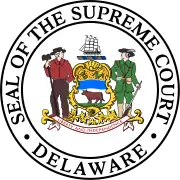Paramount Communications, Inc. v. QVC Network, Inc.
In Paramount Communications, Inc. v. QVC Network, Inc., 637 A.2d 34 (Del. 1994), the Delaware Supreme Court clarified the type of transaction that triggers Revlon duties.
| Paramount Communications, Inc. v. QVC Network, Inc. | |
|---|---|
 | |
| Court | Supreme Court of Delaware |
| Full case name | Paramount Communications, Inc., Viacom Inc., Martin S. Davis, Grace J. Fippinger, Irving R. Fischer, Benjamin L. Hooks, Franz J. Lutolf, James A. Pattson, Irwin Schloss, Samuel J. Silberman, Lawrence M. Small, and George Weissman v. QVC Network Inc. (In re Paramount Communications Inc. Shareholders' Litigation) |
| Decided | February 4, 1994 |
| Citation(s) | 637 A.2d 34 (Del. 1994) |
| Court membership | |
| Judge(s) sitting | E. Norman Veasey, Chief Justice, Andrew G. T. Moore II & Randy J. Holland, Justices |
Facts
This case involved a proposed merger between Viacom and Paramount Communications; as part of the merger agreement, Paramount agreed to an array of defensive measures, including a no-shop provision, $100 million termination fee and a lock-up option on approximately 20% of Paramount’s common stock. However, QVC intervened with its own, facially more generous merger proposal, conditioned on cancellation of the defensive measures. The Paramount board refused to conduct a formal bidding process with QVC on the grounds that it would be inconsistent with its contractual obligations to Viacom.
Holding
- Revlon triggers
- When a corporation undertakes a transaction which will cause (a) a change in corporate control, or (b) a break-up of the corporate entity, the directors' obligation is to seek the best value reasonably available to the stockholders
- Burden of proof
- The "directors have the burden of proving that they were adequately informed and acted reasonably."
- Key features of the enhanced scrutiny test
- The courts will look into the adequacy of the directors’ decision making process, including what information they used in coming to their decision. In addition, the court will consider the reasonableness of the directors’ action in light of the circumstances then existing.
See also
External links
- Text of Paramount Communications, Inc. v. QVC Network, Inc., 637 A.2d 34 (Del. 1994) is available from: CourtListener Google Scholar Justia